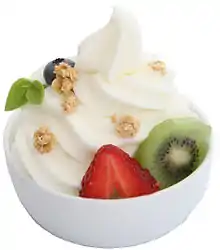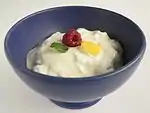Frozen yogurt
Frozen yogurt is a frozen dessert made with yogurt and sometimes other dairy and non-dairy products.[1] Frozen yogurt is a frozen product containing the same basic ingredients as ice cream, but contains live bacterial cultures.[2]
 Tart flavored frozen yogurt | |
| Place of origin | United States |
|---|---|
| Main ingredients | Milk solids, sweetener, milk fat, yogurt culture |
Usually more tart than ice cream, as well as lower in fat (due to the use of milk instead of cream), it is different from ice milk and conventional soft serve.[3] Unlike yogurt, frozen yogurt is not regulated by the U.S. Food and Drug Administration (FDA),[4] but is regulated by some U.S. states, such as California.[5]
Production
.jpg.webp)
Frozen yogurt consists of milk solids, some kind of sweetener, milk fat, yogurt culture (commonly Lactobacillus bulgaricus and Streptococcus thermophilus), plus flavorings and sometimes coloring (natural or artificial).[1][3]
Milk fat comprises about 0.55–6% of the yogurt; added in quantities inversely proportional to the amount of milk solids, it lends richness to the yogurt.[1] Milk solids account for 8–14% of the yogurt volume, providing lactose for sweetness and proteins for smoothness and increased resistance to melting. Sugar (beet or cane) provides 15–17% of the yogurt ingredients; in addition to adding sweetness, it increases the volume of solid ingredients, improving body and texture. Gelatin and/or vegetable additives (guar gum, carrageenan) stabilize the yogurt, reducing crystallization and increasing the temperature at which it will melt. This stabilization ensures that the frozen yogurt maintains a smooth consistency regardless of handling or temperature change.
Major companies often use assembly lines specifically dedicated to frozen yogurt production. Milk products and stabilizing agent(s) are combined and homogenized. At 32°C, the yogurt culture is added. The mix remains at this temperature until it sets and is ready for cooling. After that, the mix is cooled at a temperature of 0 to 4°C. Once it has reached the desired temperature and viscosity, the yogurt is allowed to sit in aging tanks for up to four hours. Sweeteners, flavorings and colorings are then mixed in, and the yogurt mixture is cooled at a temperature of −6 to −2°C. To create extra volume and smooth consistency, air is incorporated into the yogurt as the mixture is agitated. With sufficient amount of air in it, the yogurt gets rapidly frozen to prevent formation of large ice crystals, and then stored in a cold place to be shipped.
Frozen yogurt can be made in a soft serve freezer much the same way as soft ice cream. Frozen yogurt mix is sold in either powder form that needs to be mixed with water or liquid form ready to pour into a soft serve machine. A mix with high or low fat content can be chosen, and the amount of air introduced into the soft serve frozen yogurt is variable. The higher the fat level, the more air the yogurt can absorb; and the more air goes into the mix as it freezes, the creamier the product will taste.
Uses

Frozen yogurt is served in a large variety of flavors and styles. It also has sugar-free and fat-free alternatives. Frozen yogurt shops usually offer a multitude of toppings, from fruit to nuts, popular cookie brands and candies. Some companies offer a more tart version considered closer to the original recipe, whereas others focus on making their own taste more like ice cream.[6]
References
| Wikimedia Commons has media related to Frozen yogurt. |
- "Yogurt; CFR 131.200" (PDF). US Government Code of Federal Regulations. Retrieved 19 July 2018.
- "Dairy product - Ice cream and other frozen desserts". Encyclopedia Britannica. 2020. Retrieved 2020-05-07.
- Natalie Tsevdos (2018). "Yogurt". Food source information, Colorado State University. Retrieved 2020-05-07.
- "Federal Register / Vol. 74, No. 10 / January 15, 2009 / Proposed Rules" (PDF). Gpo.gov. Retrieved 19 July 2018.
- "Article 7. Frozen Yogurt - Sections 36991-36994 :: California Food and Agricultural Code :: 2005 California Code :: California Code :: US Codes and Statutes :: US Law :: Justia". Law.justia.com. Retrieved 2015-03-22.
- Steinhauer, Jennifer (2007-02-21). "Heated Competition. Steaming Neighbors. This Is Frozen Yogurt?". New York Times. Retrieved 2007-02-21.
